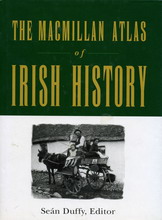

|
|

The Macmillian Atlas of Irish History
Duffy, Sean (ed.)
Publisher: Macmillan, New York, USAYear Published: 1997 Pages: 144pp ISBN: 0-02-862011-9 Library of Congress Number: DA911.M26 Dewey: 941.5DC21 Resource Type: Book Cx Number: CX11915 A full-colour atlas of Irish history. Abstract: This full-colour atlas of Irish history, contains powerful graphical images and data that capture an overview of Irish history dating from ancient Celtic times to the IRA occurrences of 1997. Each section is composed of a map accompanied by concurrent data. The book is separated into five major components. The first section talks about the origins of human settlement in Ireland, detailing the anthropological development of the Neolithic settlers, and their eventual progression into the Bronze and Iron ages, which led into Christianity in the 5th century. The second section describes the church reforms of the 12th century, at a time when many aspects of law, philosophy and theology were challenged as the Irish population increased in size into the Middle Ages. The king of England took over the Irish crown and parts of the country fell into the hands of English barons. England would exploit the natural resources of Ireland after defeating the Irish armies, imposing agricultural reforms, and turning Ireland into a British colony. The third section continues from the 16th century. After Henry VIII's call for unprecedented power and separation from the Catholic Church, religious houses were sorely affected. Parliamentary forces fought against royal forces for power over Ireland. The political power of the English Crown became centralized in Dublin by 1600 and Ireland was under the Elizabethan administration. Part four is about Ireland until the 19th century. Ireland was grappling with its colonial subordination to Britain and an Anglophone elite ruled its preeminently Catholic Gaelic population. Economic and legal systems further developed as Ireland was given legislative powers by England in the early 1690s, giving Irish Protestants a central role in the administration of 'their' kingdom. Part five deals with 20th-century Ireland. Its political, economic, social modernization made it an integral part of European affairs with an enormous contribution to the Great War. This included the election of Mary Robinson, the Northern Crisis, the political and social instability of the 1970s and 1980s, the economic and social change of the 1960s, and Northern Ireland. The atlas shows geographically varied aspects of historical progress in Ireland. It provides a variety of annotated maps that explain different topics concerning major segments of Irish history. These include the spread of Christianity, the nature of Norman colonization, the impact of the Reformation, the Elizabethan, Cromwellian, and Williamite wars, the revival of the Catholic Church, the Famine, the rise of nationalism and the conflict of the 1990s in Northern Ireland. It is written by a combination of 5 experts in Irish history and edited by Sean Duffy. [Abstract by Vei Chong] Table of Contents Preface Part I: Origins Celtic Ireland Early Peoples and Politics The Golden Age Ireland and Europe The Viking Wars The Age of Brian Boru Reform of the Church Ireland before the Normans Part II: The English Conquest The English Invasion Expansion of the Colony Irish Resistance The Decline of English Power The Gaelic Revival The Late Middle Ages The Growth of Dublin Part III: Reformation to Restoration The Protestant Reformation Elizabethan Administration Plantation and Resistance O'Neill's Rising Jacobean Plantations The Rising of 1641 Cromwell's Campaigns and Administration The Williamite Revolution Part IV: From Splendor to Famine The Penal Laws The Georgian Economy The Government of Ireland, 1692-1785 The 1798 Rebellion Catholic Emancipation and Repeal Nineteenth-Century Catholicism The Pre-Famine Economy Emigration to 1845 The Great Famine The Decline of the Irish Language Part V: Modern Ireland Post-Famine Emigration Economic Development before the Great War The Growth of Irish Nationalism Government Policy The Ulster Question The Great War and the Easter Rising Separation 1916-23 Cumann na nGaedheal Fianna Fail The '40s and '50s: Turmoil and Malaise Northern Ireland The '60s: Economic and Social Change The '70's and the '80s: Political and Social Instability The Northern Crisis Ireland in the '90s Chronology Further Reading Index Acknowledgments Subject Headings |